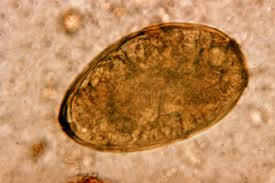Paragonimus
Background

- Parasitic lung fluke
- Infectious species found mainly in East/Southeast Asia, Africa, and Central/South America. Rare reports of infection acquired in the Midwest US
- Transmission via ingestion of undercooked crab or crayfish
Clinical Features
- Onset 2-15 days
- Diarrhea, abdominal pain
- Followed by fever, chest pain, fatigue
- Cough: sputum may be rusty or blood-tinged
- Symptoms similar to TB or chronic bronchitis
- CNS disease (found in 25% of hospitalized patients)
- Meningitis, HA, seizure, visual disturbances
- May also invade liver, spleen, intestinal wall, peritoneum, abdominal lymph nodes
Differential Diagnosis
Cestodes (Tapeworms)
- Taenia saginata
- Taenia solium (Cysticercosis)
- Diphyllobothrium latum
- Hymenolepis nana
- Echinococcus granulosus
Trematodes (Flukes)
- Fasciola hepatica
- Fasciolopsis buski
- Opistorchis viverrini
- Schistosoma spp
- Chlonorchis sinensis
- Paragonimus spp.
Nematodes (Roundworms)
- Ascaris lumbricoides
- Enterobius vermicularis (Pinworm)
- Filarial worms
- Loa Loa
- Onchocerciasis
- Lymphatic filariasis (Elephantiasis)
- Wuchereria bancrofti
- Brugia malayi
- Brugia timori
- Hookworm
- Necator americanus
- Ancylostoma duodenale
- Cutaneous larva migrans (Ancylostoma braziliense)
- Dracunculus medinensis
- Strongyloides stercoralis
- Trichuris trichiura (Whipworm)
- Anisakis
- Toxocara spp.
- Trichinosis
Evaluation
- Diagnosis made by sputum (though parasite is killed by acid-fast testing for TB)
- CBC: may have marked eosinophilia
- CXR: range of findings (lobar infiltrates, calcified nodules, coin lesions, pleural thickening) but characteristic finding is ring-shaped opacities of contiguous cavities that look like a bunch of grapes
- CT head: may also see "bunch of grapes" type cavities if CNS involvement
Management
- Praziquantel 25mg/kg q8h x 2 days
- Add short course of corticosteroids if CNS involvement to reduce inflammatory response to dying flukes
Disposition
See Also
External Links
References
This article is issued from
Wikem.
The text is licensed under Creative
Commons - Attribution - Sharealike.
Additional terms may apply for the media files.